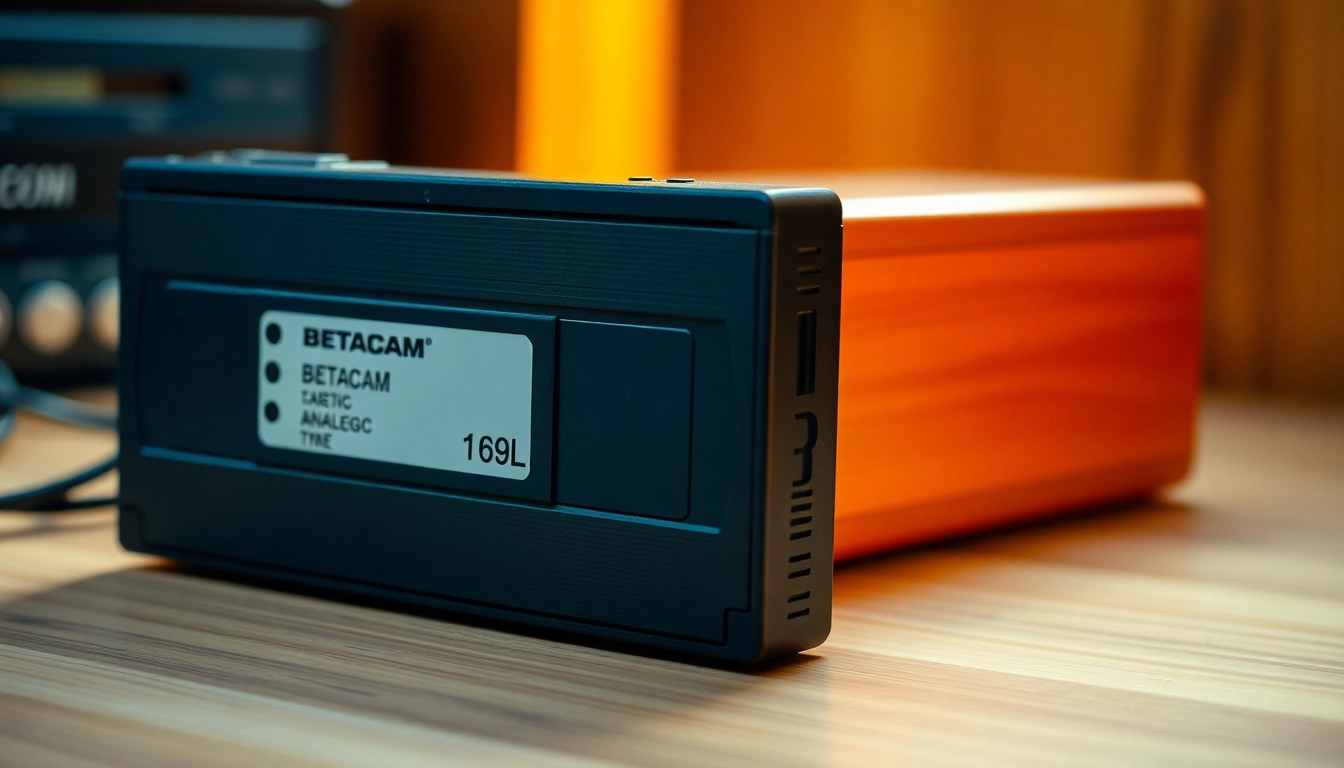Understanding the Betacam Format
History and Evolution of Betacam
The Betacam format, introduced by Sony in the early 1980s, revolutionized video production by offering high-quality image and sound. Designed initially for the broadcast industry, Betacam became synonymous with professional video recording. Over the years, several variations emerged, including Betacam SP, Betacam SX, and Digital Betacam (DigiBeta), each enhancing its predecessor’s capabilities. Betacam’s evolution reflects advancements in technology, facilitating creators, videographers, and broadcasters in their mission to produce compelling visual content.
Types of Betacam Tapes
Betacam tapes are categorized into several types, each optimized for specific applications:
- Betacam: The original format introduced in 1982, offering a resolution of 330 lines.
- Betacam SP: Released in 1986, this version improved color depth and resolution, providing around 450 lines of quality.
- Digital Betacam (DigiBeta): Launched in 1993, DigiBeta marked a significant leap, utilizing digital recording technology for up to 500 lines of resolution.
- Betacam SX: An enhanced format that supports higher data compression while maintaining excellent quality, ideal for extended recording times.
Why Convert Betacam to Digital?
Converting Betacam tapes to digital formats is crucial for several reasons. First, digital media preserves the quality of the original content, preventing degradation over time. Second, it allows for easier access and distribution, enabling creators to share their work across various platforms. Lastly, digital storage solutions provide greater flexibility, making it easier to archive and safeguard precious memories. For anyone looking to transition their old footage into a more accessible format, converting to Betacam to Digital presents a valuable opportunity.
The Benefits of Digital Conversion
Preserving Quality and Access
Digital conversion of Betacam tapes ensures that the quality of original footage is preserved. Unlike analog formats that are susceptible to degradation with each playback, digital formats maintain their integrity. Moreover, high-definition digital files can be easily edited, enhanced, and shared, making them more accessible than ever before. Accessibility isn’t merely a convenience; it democratizes content, allowing it to reach wider audiences across various digital platforms.
Storage Solutions for Digital Media
Transitioning to digital opens up various storage options. While physical Betacam tapes take up space and are vulnerable to damage, digital files can be stored on hard drives, cloud services, or even external storage devices. This flexibility not only frees up physical space but also ensures that backups can be easily created and managed. Additionally, digital files can be organized efficiently, allowing for quick retrieval and easier content management.
Environmental and Cost Benefits
Converting to digital formats offers environmental advantages as well. Less physical media means reduced demand for materials that contribute to waste. Moreover, maintaining a digital library is often more cost-effective over time compared to the constant need for physical tape storage and maintenance. As technology continues to improve, the costs of digital storage and editing tools continue to decrease, making this shift both financially and environmentally smart.
Choosing a Betacam to Digital Conversion Service
Key Features to Look For
When selecting a Betacam to digital conversion service, it’s essential to consider several factors to ensure the best outcome. Key features include:
- Equipment Quality: State-of-the-art VTR (Video Tape Recorder) decks designed specifically for Betacam tapes ensure high-quality transfers.
- Format Options: The service should offer multiple output formats, including MP4, MOV, and others to cater to various needs.
- Customer Support: Reliable customer service is crucial, especially if you have questions about the conversion process or the status of your tapes.
- Reviews and Credentials: Look for services with positive customer reviews and industry experience, as they are more likely to deliver satisfactory results.
Price Comparison and Packages
Prices for Betacam to digital conversion can vary significantly. While some services charge per tape, others may offer packages for bulk conversions, which can save you money if you have a large collection of tapes. It’s important to compare prices but also consider what is included in those prices—such as video quality, editing, and delivery format options. Transparency in pricing is essential to avoid unexpected costs. Often, good service will provide clear quotes and stick to the agreed-upon price.
Customer Reviews and Testimonials
Reading customer reviews and testimonials can provide insight into the reliability and quality of service offered by specific conversion companies. Look for feedback that discusses not only the output quality but also the experience regarding customer service and turnaround time. Websites, social media, and review platforms can be great resources for gathering this information.
Step-by-Step Guide to Conversion
Preparing Your Betacam Tapes
Preparing your tapes for conversion is a crucial step. First, evaluate each tape’s condition, checking for any visible damage or mold. It’s essential to clean the tapes and store them in a dry, cool location to prevent degradation. If possible, test playback to ensure that tapes can still be used effectively. Organizing your tapes ahead of the conversion can also speed up the process, allowing for a smoother transition.
Selecting the Right Output Format
Choosing the correct output format is vital for future accessibility. Common formats include:
- MP4: Highly versatile and supported by almost all devices, making it an excellent choice for videos.
- MOV: Ideal for high-quality edits and used often in professional video editing software.
- MOV for Web: A variant designed specifically for web and online use.
Your choice should be guided by how you intend to use the footage after conversion—whether for online sharing, personal archives, or professional editing.
Post-Conversion Management of Files
Once your Betacam tapes are converted, managing the digital files effectively is crucial. Implement a naming convention to organize your files logically, based on dates or projects. Create multiple backups—store copies in the cloud, on external hard drives, and USB drives to ensure that your valuable footage is safe. Regularly check the integrity of these storage devices over time, as hardware can fail and data can become corrupted.
Common Challenges and Solutions
Technical Issues During Conversion
Technical issues can arise during the conversion process, such as playback problems or technical discrepancies with older equipment. To mitigate these challenges, ensure that the conversion service uses updated technology capable of handling Betacam formats effectively. Working with a reputable service that understands Betacam technology will minimize these risks. Always confirm that they can troubleshoot and rectify problems as they arise.
Choosing the Right Equipment
Choosing appropriate equipment for conversion is essential. Professional-grade VTRs designed for the specific Betacam format you possess will produce the best results. Ensure that the service uses well-maintained, high-quality equipment that is regularly calibrated. Inquire about the equipment used before committing to a service to ensure quality.
Maintaining Quality Through the Process
During the conversion process, maintaining the best possible quality is crucial. Work with services that offer monitoring during the transfer process, ensuring that color correction, noise reduction, and other enhancements are applied where necessary. Request samples of their work or a trial conversion before committing to a long-term service to evaluate their quality.



